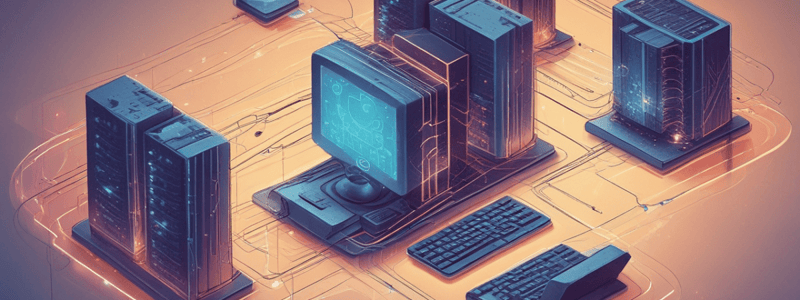Podcast
Questions and Answers
What is the primary purpose of distributing network or application traffic across multiple servers?
What is the primary purpose of distributing network or application traffic across multiple servers?
to enhance system availability and reliability, improve response times and overall performance, and ensure fault tolerance and scalability.
What are the two types of load balancers based on the OSI model layers they operate on?
What are the two types of load balancers based on the OSI model layers they operate on?
Layer 4 (Transport Layer) Load Balancers and Layer 7 (Application Layer) Load Balancers.
What is the outcome of not using load balancing in a network or application?
What is the outcome of not using load balancing in a network or application?
A single server becomes overwhelmed, leading to poor resource utilization, slow response times, and potential overload.
What is the concept of distributing requests sequentially across the pool of servers in a circular order?
What is the concept of distributing requests sequentially across the pool of servers in a circular order?
What is the algorithm that routes traffic to the server with the fewest active connections?
What is the algorithm that routes traffic to the server with the fewest active connections?
What is a device designed for high-performance load balancing, often providing advanced features like SSL offloading and DDoS protection?
What is a device designed for high-performance load balancing, often providing advanced features like SSL offloading and DDoS protection?
What is the process of decrypting incoming SSL/TLS traffic at the load balancer and then forwarding it as plain HTTP to backend servers?
What is the process of decrypting incoming SSL/TLS traffic at the load balancer and then forwarding it as plain HTTP to backend servers?
What is the concept of directing incoming requests from a client to the same backend server for the duration of a session?
What is the concept of directing incoming requests from a client to the same backend server for the duration of a session?
What are the benefits of using Layer 7 (Application Layer) Load Balancers?
What are the benefits of using Layer 7 (Application Layer) Load Balancers?
What is the advantage of using a hardware load balancer over a software-based solution?
What is the advantage of using a hardware load balancer over a software-based solution?
What is the primary purpose of session persistence in load balancing, and how does it achieve this?
What is the primary purpose of session persistence in load balancing, and how does it achieve this?
What are the key differences between traditional load balancing and Global Server Load Balancing (GSLB)?
What are the key differences between traditional load balancing and Global Server Load Balancing (GSLB)?
What are the advantages of using software load balancers over hardware load balancers?
What are the advantages of using software load balancers over hardware load balancers?
How does geolocation-based routing improve latency and user experience?
How does geolocation-based routing improve latency and user experience?
What is the primary function of a reverse proxy, and how does it relate to load balancing?
What is the primary function of a reverse proxy, and how does it relate to load balancing?
What is the primary advantage of using predictive load balancing over traditional load balancing?
What is the primary advantage of using predictive load balancing over traditional load balancing?
What is the benefit of separating the data plane and control plane in load balancing, and how does it improve scalability and security?
What is the benefit of separating the data plane and control plane in load balancing, and how does it improve scalability and security?
What is the primary purpose of health checks in load balancing, and how do they improve the overall reliability of the system?
What is the primary purpose of health checks in load balancing, and how do they improve the overall reliability of the system?
What is the primary difference between an Application Delivery Controller (ADC) and a traditional load balancer?
What is the primary difference between an Application Delivery Controller (ADC) and a traditional load balancer?
What is the primary purpose of content-based load balancing, and how does it differ from traditional load balancing?
What is the primary purpose of content-based load balancing, and how does it differ from traditional load balancing?
What is the primary goal of cost-aware load balancing, and how does it achieve this goal in multi-cloud environments?
What is the primary goal of cost-aware load balancing, and how does it achieve this goal in multi-cloud environments?
How does edge load balancing improve user experience, and what is the key benefit of processing requests at geographically dispersed edge locations?
How does edge load balancing improve user experience, and what is the key benefit of processing requests at geographically dispersed edge locations?
What is the primary benefit of using synthetic monitoring in load balancing, and how does it help identify potential issues?
What is the primary benefit of using synthetic monitoring in load balancing, and how does it help identify potential issues?
What is the key benefit of service mesh integration in load balancing, and how does it manage microservices communication?
What is the key benefit of service mesh integration in load balancing, and how does it manage microservices communication?
What is the primary advantage of using load balancing in multi-cloud deployments, and how does it enhance redundancy and flexibility?
What is the primary advantage of using load balancing in multi-cloud deployments, and how does it enhance redundancy and flexibility?
What is the primary benefit of using distributed tracing in load balancing, and how does it help optimize load balancing configurations?
What is the primary benefit of using distributed tracing in load balancing, and how does it help optimize load balancing configurations?
What is the primary advantage of using application-layer processing in load balancing, and how does it offload tasks from backend servers?
What is the primary advantage of using application-layer processing in load balancing, and how does it offload tasks from backend servers?
What is the primary benefit of using real-time log analysis in load balancing, and how does it help adjust load balancing strategies dynamically?
What is the primary benefit of using real-time log analysis in load balancing, and how does it help adjust load balancing strategies dynamically?
How does cost-aware load balancing optimize resource allocation in multi-cloud environments, and what are the implications of vendor lock-in?
How does cost-aware load balancing optimize resource allocation in multi-cloud environments, and what are the implications of vendor lock-in?
What is the primary benefit of integrating edge load balancing with service mesh integration, and how does it enhance overall system performance?
What is the primary benefit of integrating edge load balancing with service mesh integration, and how does it enhance overall system performance?
Flashcards are hidden until you start studying
Study Notes
What is Load Balancing?
- Load balancing is the process of distributing network or application traffic across multiple servers to ensure no single server becomes overwhelmed, optimizing resource use, maximizing throughput, minimizing response time, and avoiding overload.
Types of Load Balancers
- Layer 4 (Transport Layer) Load Balancers
- Layer 7 (Application Layer) Load Balancers
Primary Purpose of Load Balancing
- The primary purpose of load balancing is to enhance system availability and reliability, improve response times and overall performance, and ensure fault tolerance and scalability.
Load Balancing Algorithms
- Round Robin: distributes requests sequentially across the pool of servers in a circular order
- Least Connections: routes traffic to the server with the fewest active connections, balancing the load more evenly
Hardware Load Balancer
- A dedicated device designed for high-performance load balancing, often providing advanced features like SSL offloading and DDoS protection
- Example: F5 BIG-IP
SSL Termination
- The process of decrypting incoming SSL/TLS traffic at the load balancer and then forwarding it as plain HTTP to backend servers, offloading the computational overhead from the application servers
Session Persistence (Sticky Sessions)
- Ensures that a user’s session is consistently directed to the same server for the duration of the session, crucial for applications where session data is stored locally on the server
Global Server Load Balancing (GSLB)
- Distributes traffic across multiple geographic locations to enhance global availability and disaster recovery capabilities, often by directing users to the nearest data center
Software Load Balancers
- Offer flexibility, can be deployed on standard servers, and are suitable for both on-premises and cloud environments
- Can be easily integrated with existing systems and provide customizable routing policies
Geolocation-Based Routing
- Directs traffic based on the geographic location of the client, aiming to improve latency and user experience by routing to the nearest data center
Reverse Proxy
- A server that forwards client requests to backend servers
- Often performs load balancing by distributing incoming requests among multiple backend servers
Predictive Load Balancing
- Uses historical data and predictive analytics to anticipate traffic patterns and pre-emptively adjust resource allocation, helping to prepare for expected traffic spikes
Separating Data Plane and Control Plane
- Enhances scalability, flexibility, and security by allowing the control plane to manage configuration and policy decisions independently from the data plane, which handles actual traffic routing
Health Checks
- Monitor the health of backend servers
- Load balancers perform regular checks and remove unresponsive servers from the pool, ensuring traffic is only directed to healthy servers
Application Delivery Controller (ADC)
- An advanced load balancing device that provides additional services such as application acceleration, compression, SSL offloading, security features, and real-time traffic analysis
Content-Based Load Balancing
- Routes traffic based on the content of the request, such as specific URLs, headers, or cookies, enabling more sophisticated routing decisions
Traffic Mirroring
- Duplicates live traffic to multiple environments for testing and analysis without impacting production
- Used for performance testing, A/B testing, and debugging
Canary Releases
- Involves directing a small portion of traffic to a new version of an application to test its performance and functionality before rolling it out to the entire user base
Mutual TLS (mTLS)
- Ensures both the client and server authenticate each other, enhancing security by preventing unauthorized access and man-in-the-middle attacks
Load Balancing and DDoS Attacks
- Help mitigate DDoS attacks by distributing traffic across multiple servers, absorbing and deflecting malicious traffic, and integrating with DDoS protection services
Latency-Aware Load Balancing
- Continuously measures latency between clients and servers, directing traffic to the server with the lowest latency for each client, enhancing user experience by reducing response times
Cost-Aware Load Balancing
- Optimizes resource allocation based on cost considerations, particularly in multi-cloud environments where pricing models vary, directing traffic to the most cost-effective resources
Edge Load Balancing
- Distributes traffic at the network edge, closer to end users, reducing latency and enhancing performance by processing requests at geographically dispersed edge locations
Synthetic Monitoring
- Uses simulated transactions to test and monitor system performance, helping to identify potential issues before they impact real users and ensuring proactive load balancing management
Service Mesh Integration
- Involves managing microservices communication through a dedicated infrastructure layer, providing fine-grained traffic management, observability, and security features
Load Balancing in Multi-Cloud Deployments
- Distributes traffic across multiple cloud providers, enhancing redundancy, avoiding vendor lock-in, and leveraging the strengths of different cloud environments
Distributed Tracing
- Tracks requests as they propagate through microservices architectures, providing insights into request paths, latency, and bottlenecks, and helping to optimize load balancing configurations
Application-Layer Processing
- Allows for advanced features like SSL termination, HTTP/2 support, WebSocket handling, and content-based routing, offloading these tasks from backend servers and enhancing performance
Real-Time Log Analysis and Load Balancing
- Monitors traffic patterns, server performance, and user behavior, providing insights that can be used to adjust load balancing strategies dynamically, ensuring optimal performance and quick identification of issues
Studying That Suits You
Use AI to generate personalized quizzes and flashcards to suit your learning preferences.





